ACME ADAPTERS EXTREME HI-STEER
Because I plan to do a lot of offroading with the Samurai and because I can take the tougher trails with the little car ( as opposed to the big Chevy ) I decided I needed at least a locking rear.
What is a locker? It is short for locking differential. The differential is that big "bulge" in the middle of your axle that allows the left and right axles to differentiate while you go around a corner. Normally, one slows down while the other speeds up. If you just had a solid axle connecting the left and right sides together, turning the corner would be much more difficult than you can imagine. Since both tires would be forced to travel at the same speed, and neither of them likes this, they would drag and slide their way around the corner and make for some very undesired driving indeed.
A regular open diff keeps the average RPM of both axles constant relative to the drive shaft rpm. In an open diff, with one wheel experiencing a complete loss of traction (0 RPM), the other wheel will be turning at twice the RPM that it would be if both wheels were at the same rpm - relative to the drive shaft. This happens because of the spider
gears. So, when an open diff is going through a turn, and good traction is available (asphalt road), the outside wheel turns faster and the inside wheel turns slower than if both were going in a straight line with a constant vehicle speed.
In an automatic locker design, which does not use spider gears, at least one wheel must turn the same (relative) rpm as the drive shaft while the other wheel can turn faster (but not slower). In most all automatic locker designs, the inboard wheel drives at the same (relative) RPM as the drive shaft and the outboard wheel unlocks and travels at the increased ground speed which is what is driving
it.
Looking through all the available options ( just do a search for difflock ) and talking to several users/sellers I finally decided to go for a "QuickLok", an automatic positive locking differential. It installs into the existing diff without too many problems.
January 21 2005:
I had it installed by Arno from Suzi's Place, Buren because I wasn't too sure I could do it myself after seeing all the pictures of diffs taken apart on the Internet. Arnold, the mechanic at Suzi's Place and I took the wheel/brakes off, took the axles out, unbolted the diff and cleaned all the surfaces before re-install.
Original diff ( and it looks the same re-assembled, just cleaner ;-) ):

No problem yet, just take some parts off
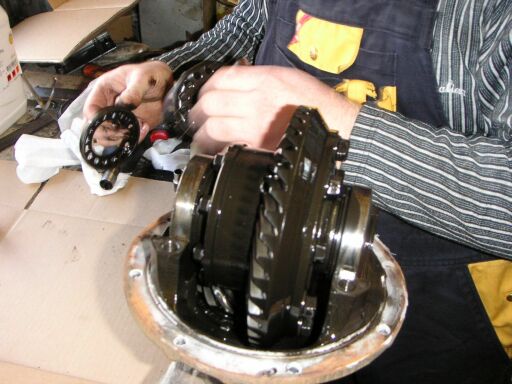
But this is where I started to get a little nervous :
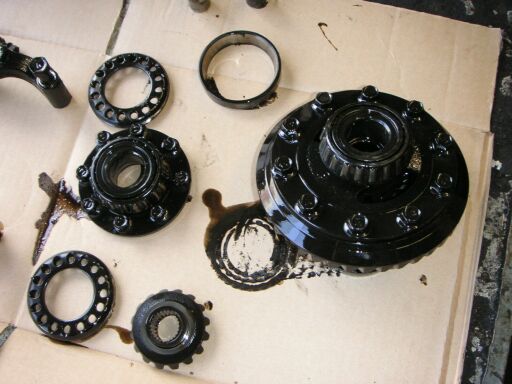
Looking into the diff ( after taking it apart ) you can see the "satelite"gears which can rotate around the small axles or cross-pins ( one long one and two short ones, making a cross into the square carrier ) These allow the axles/wheels to turn independently, so when one wheel loses grip, the other one gets all the power (but that's not the side you want the wheel to spin when you're stuck ):
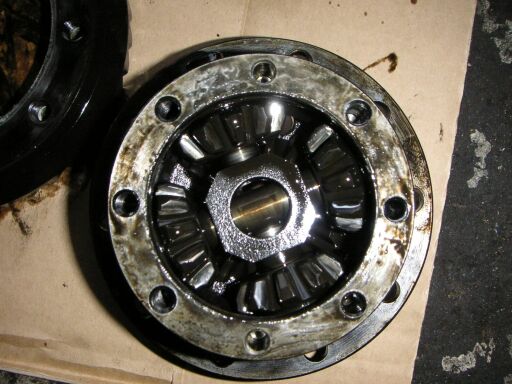
Parts that came out and will not be used again ( or will end up as wheels or headlight of a small motorcycle welded together from left-overs ), the satelite gears and cross-pins:
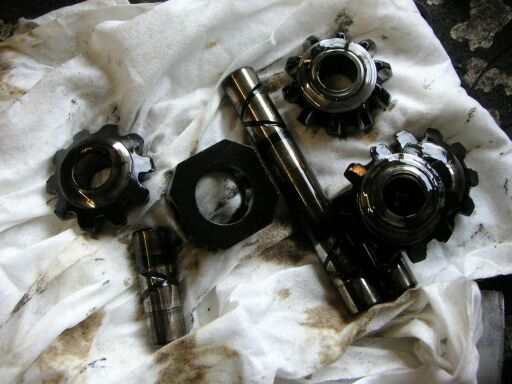
New gears ( clutch assembly as they are called ) and cross-pins, with springs and caps in plastic bag ):

One clutch installed ( ring underneath ), new cross-pins installed, spring and cap are not yet installed into the elongated holes:
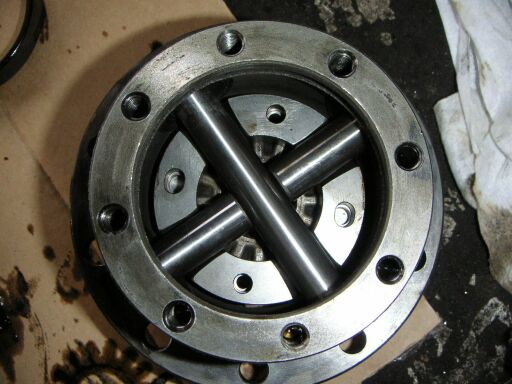
After installing the spring/cap assembly in the elongated holes of the lower clutch and "glueing" them into the top clutch with some grease ( so they wouldn't fall out upside down during installing ), Arno lowered the top clutch onto the lower clutch, making sure the springs landed in the opposing round holes:
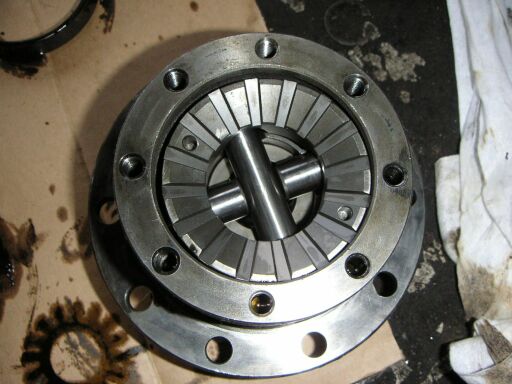
Original side gear back in place, the splines you see is where the axle goes in ( there's one on the other side as well of course ):

Bearing back on.....
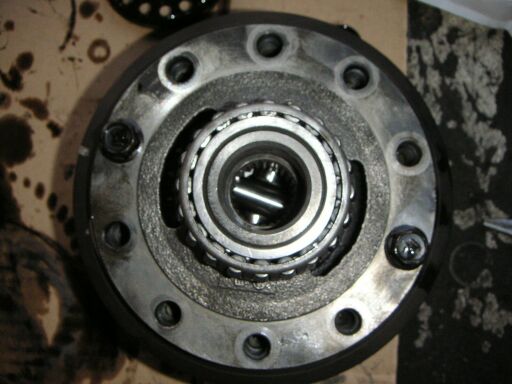
.......and everything bolted back together after making sure the bearings were in straight and tightened to factory specs, oiled every part, put new gasketkit on all the surfaces, bled the brakes ( as my Samurai is a Japanese one, we had to take the backing plates off to get the axles out, on a Spanish Samurai you can pull the axles with te backing plate on ), put the wheels back on and it was time for coffee and a cigar ( for me anyway, the guys don't smoke ;-) )
The way it works is as follows:
An OPEN ( original ) differential is one where ALL of the torque is sent to the wheel with the LEAST amount of traction. This is why one wheel will spin while the other doesn't.
A LOCKER locks the axles together, sending equal power to both wheels, ensuring that the wheel with the most traction turns.
Found this on the JPMagazine site:
Lockers for dummies
Ever been driving off-road having a grand ol’ time, blasting this way and that way, then—boom—you hit a mudhole that is just a tad too big? All of a sudden your
car won’t move and both of the tires with the least traction are spinning like crazy while the two tires on dry ground, which would pull you out, won’t budge. You’ve just found out why you need a locker. Your
car with open differentials allows one of your wheels to turn at a different speed than the other. This allows you to go around corners without chirping and spinning the tires, but it is also what has just stopped your fun. A locker does just that—it locks the two axleshafts together forcing both tires to turn no matter what conditions the tires are under. So how does it work on the street? Ideally, a locker like a
QuickLok will allow the outside wheel to turn faster than the inside wheel and therefore will keep your tires from chirping and slipping around corners. How does the locker do that, you ask? Well, some questions are better left
unanswered. We do not question the locker’s importance, but simply appreciate that we have it.
Now all I have to do is find some mud and find out if it works ;-) ( it does !!! )